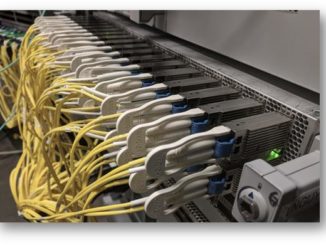
It’s a familiar story arc for open source efforts started by vendors or vendor-led industry consortiums. The initiatives are launched and expanded, but eventually they find their way into independent open source organizations such as the Linux Foundation, where vendor control is lessened, communities are able to grow, and similar projects can cross-pollinate in hopes of driving greater standardization in the industry and adoption within enterprises.
It happened with Xen, the virtualization technology that initially started with XenSource and was bought by Citrix Systems but now is under the auspices of the Linux Foundation. The Linux kernel lives there, too, and is where Linus Tovalds gets his paychecks, as does the Cloud Native Computing Foundation, which controls the Kubernetes container controller and the converged container format that is based on Docker and rkt. The Nodes.js, Open vSwitch, HyperLedger, OpenHPC, and a slew of other infrastructure software projects are managed from the Linux Foundation.
In recent years, the same story happened in the fast-growing Internet of Things space. As the IoT burst onto the scene several years, a broad array of vendors saw the need to develop foundational interoperability standards that would enable the myriad connected systems coming onto the market to securely communicate with each other. Getting enterprise buy-in on the benefits of the IoT would be difficult if one device could not talk with another. That push gave birth to an array of vendor-backed industry groups, from the AllSeen Alliance launched by the likes of Qualcomm, Dell, Intel, Samsung and Broadcom, the Open Interconnect Consortium (Intel, Broadcom, Samsung, and now called the Open Connectivity Foundation, or OCF), the Thread Group (Google, Samsung, and Arm) and the Industrial Internet of Things (IBM, AT&T, Cisco, Intel and others). Over the years, there has been various cross-group working agreements and consolidations, and now the Linux Foundation is home to a range of IoT-related project, including the OCF (which absorbed the Allseen Alliance last year). Earlier this year, the open source organization announced a new IoT project, EdgeX Foundry, whose founding members include Dell, AMD, and VMware.
The story is similar in the network virtualization space. Several years ago, there were a host of vendor-led industry consortiums that sprang up with the idea of building a common framework for software-defined networking (SDN) and network-functions virtualization (NFV). Virtualization has been commonplace in servers and storage devices for a decade, but the network for many years continued to be a place of hardware-based systems from the likes of Cisco and Juniper Networks, where many of the network tasks like firewalls, load balancing and intrusion prevention and detection were locked inside proprietary switches. SDN essentially decouples the network control plane from the underlying hardware and enables networking to run on industry-standard systems, and NFV takes those networks tasks, put them into software that can run on servers. The goal is to create networks that are highly programmable, scalable and affordable, putting them on part with other datacenter resources.
Industry like the OpenDaylight Foundation (launched in 2013 by IBM, Cisco, Microsoft and others) and Open Networking Foundation (or ONF) and Open Platform for NFV (OPNFV) were created to develop common platforms for SDN and drive adoption among enterprises. OpenDaylight and OPNFV are now under the auspices of the Linux Foundation, as is the Open Network Automation Platform (ONAP), created early this year in a merger of AT&T’s ECOMP project and the Open-O network orchestration initiative. Now the foundation can add Juniper’s OpenContrail open-source network cloud platform to its lineup of SDN projects.
At its annual NXTWORK user conference this week, Juniper announced that it is moving the codebase for OpenContrail to the Linux Foundation in an effort to grow the use of the technology in cloud environments, drive faster innovation and grow the community around OpenContrail. According to Randy Bias, vice president of technology and strategy for cloud software at Juniper, the company had worked hard to grow the OpenContrail effort over the last four years, but that it had to move out of Juniper to continue growing.
“We needed to move to the next phase of OpenContrail’s open-source mission, transitioning from a community that is predominantly led by Juniper to one that is led by the community itself,” Bias told The Next Platform in an email. “Rather than create a new foundation, we opted to go by transitioning community governance to the tried and true foundation model of the Linux Foundation. The community is thrilled about these changes and we believe it will make a material difference in adoption and developer ecosystem growth.”
Juniper jumped into the SDN space in 2012 with the $176 million acquisition of startup Contrail Systems and its SDN controller, a time when established network vendors were aggressively pushing into a space that threatened the sales of expensive proprietary switches and other hardware that had driven their businesses for a couple of decades and had given rise to a broad array of smaller pure-pay SDN startups. A year later, Juniper released its Contrail products as open source and created the OpenContrail community. Earlier this year, the vendor reworked the project’s governance in hopes of making the effort more open and more community-led.
The decision to move the OpenContrail initiative to the Linux Foundation came after the company took some flak from AT&T, which has a broad underway to virtualize much of its network infrastructure and had chosen Contrail as its SDN technology. However, the service provider at the Open Networking Summit reportedly considered switching to another SDN technology due to dissatisfaction with the way Juniper was managing Contrail and the OpenContrail efforts, in particular what they saw as a lack of community involvement in the development of the technology. It was still a Juniper-led effort and AT&T wanted more people from outside of Juniper working on it.
It’s a common refrain about open-source efforts that are controlled by vendors or vendor-led groups, and is a reason why such initiatives often find their way into independent open-source groups. In this case, rather than wait for what Juniper decided to do in the development of OpenContrail, once the codebase is with the Linux Foundation, developers will be able to grab it and run with it, and take what they like from it and combine it with code from other Linux Foundation projects to shape the SDN technologies they need.
Bias said getting OpenContrail to the point and helping to grow the community around it were drivers behind the Linux Foundation decision.
“OpenContrail is the most widely deployed open source cloud-grade SDN solution available today,” he said. “It has the largest production deployments and has been battle tested by some of the world’s largest service providers. In order to get to the next phase, we need more than Juniper’s efforts, we need the efforts of a vibrant community all pulling together in unison. This is why we are making this transition.”
Juniper’s decision drew praise from Chris Rive, senior vice president of AT&T Labs, who said that the move “will further expand its community reach and spur new innovations. Projects like OpenContrail bring local network overlay control into opens source, enhancing the openness and broadening the ecosystem of software-defined networking.”
A concern with so many different projects in a particular space is fragmentation of the market. With all the SDN projects underway with the Linux Foundation, such fragmentation is possible, but Bias said he is confident that will be avoided.
“We are working closely with the Linux Foundation to coordinate resources and interoperability between all of the other interrelated networking projects,” he said. “We believe that OpenContrail can be a foundational cornerstone for much of networking that falls under the auspices of the Linux Foundation. Over time, fragmentation will inevitably reduce as some projects flourish. We believe that over time the best and most widely adopted solutions win and fragmentation naturally disappears.”
Over the past few years, Juniper has put a focus on cloud providers, not only with Contrail and OpenContrail but also other parts of its product lines. During a conference call in October to discuss third-quarter financial numbers, Ken Miller, chief financial officer at Juniper, declined to break out customer details, but did say that five of the company’s top 10 customers are cloud companies, and that the cloud companies that are customers are among the largest in the world. At the same time, the numbers from the third quarter showed a 2 percent drop in revenue, something he and CEO Rami Rahim attributed in part to a delay in spending by many cloud providers as they undergo an architectural shift, a delay that will continue in the current quarter.
Bias also told The Next Platform that while service providers have been a key part of Juniper’s efforts around OpenContrail and Contrail, there is work underway to grow more with enterprises. He pointed to customers who are running containers on top of public clouds, and pointed to moves this year to increase security around Contrail through such capabilities as multiple enforcement points and visualization, analytics and orchestration across hybrid clouds. In addition, Juniper added the Container Network Interface to Contrail Release 4.0 to integrate Kubernetes into the technology. Such new capabilities are aimed at enterprises leveraging public clouds.
“We are looking to a future where we expand out towards more enterprise developers and infrastructure IT teams who need a true multi-cloud, ubiquitous network and security fabric,” Bias said. “While today the public cloud is the wild west, at some point it will be necessary for enterprises to have a global view into their networks and security postures.”





Be the first to comment